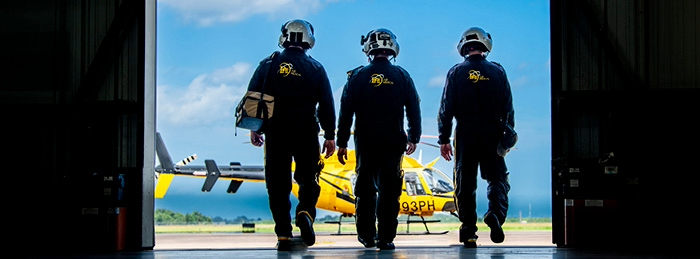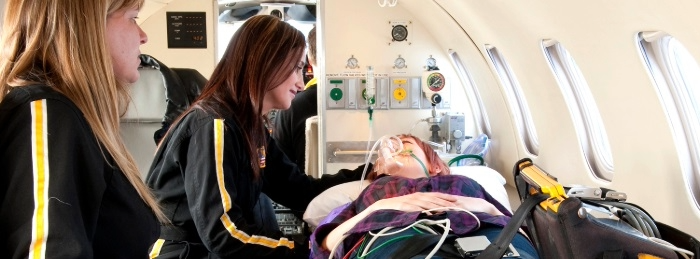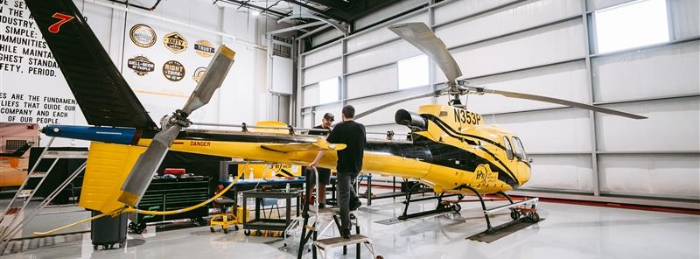National Aviation Day: The Pilots, Crew, and Technology Behind Every Flight
Every August 19th, National Aviation Day gives us an opportunity to honor the innovation, dedication, and sheer courage that shaped the aviation world. Established in 1939 by President Franklin D. Roosevelt, this day commemorates the birthday of Orville Wright, one of the Wright brothers who made the first powered flight possible. For PHI Air Medical, National Aviation Day is more than a celebration of flight; it recognizes the people and technology that make emergency air transport feasible, efficient, and safe. Behind every life-saving mission is a team of highly trained professionals and advanced aviation technology designed to operate in some of the most demanding environments.
Today, we take you behind the scenes to show what it takes to launch each flight, respond to a medical crisis, and bring someone back to safety. We highlight the pilots, crew members, maintenance teams, dispatchers, and innovative systems that make PHI Air Medical a trusted leader in emergency air medical transport.
A Legacy of Lifesaving Aviation
PHI Inc. has served communities for over 75 years, building a legacy of safety, reliability, and rapid response. With a fleet of state-of-the-art helicopters stationed across the country, PHI provides critical care transport for patients facing life-threatening emergencies. These aircraft are more than vehicles; they are fully equipped flying intensive care units (ICUs), staffed with medical professionals trained to handle the most severe medical conditions en route to specialized hospitals.
PHI Air Medical’s mission is to move communities to health while maintaining the highest standard of safety. With a robust network of bases nationwide, PHI combines expert aviation, medical care, and communication to provide critical air medical transport services. Their aircraft and crews are equipped to operate safely and efficiently across diverse environments—from deserts and mountains to rural farmlands and congested urban areas—ensuring rapid and reliable patient care when it matters most.
National Aviation Day serves as a powerful reminder of how flight—when paired with skilled medicine—can become a literal lifeline.
The Pilots: Calm in the Midst of Crisis
PHI pilots are much more than skilled aviators. Many come from military or EMS aviation backgrounds, bringing thousands of flight hours and an exceptional understanding of mission-critical operations. Their work demands calm, precision, and the ability to adapt quickly to ever-changing conditions.
Key responsibilities include:
- Conducting detailed pre-flight safety checks to ensure aircraft readiness
- Monitoring and interpreting constantly changing weather conditions
- Communicating proactively with ground EMS teams and hospital personnel
- Navigating complex terrain such as narrow canyons, power lines, or rugged mountain valleys
- Landing safely in tight or remote locations, including roadsides, fields, and mountain ridges
- Managing fatigue and stress over long or unpredictable shifts
PHI pilots constantly balance multiple variables such as weight, fuel, flight time, and alternate landing zones, while keeping patient and crew safety paramount.
The Medical Crew: Intensive Care in the Sky
Each PHI medical crew typically includes a flight nurse and a flight paramedic—experts trained far beyond standard EMS protocols. Their extensive experience covers advanced emergency and trauma care, ensuring patients receive stabilization from the moment they board.
Crew training includes:
- Advanced cardiac life support (ACLS) for adults, pediatric, and neonatal patients
- Airway management and ventilator use in confined and moving environments
- Blood product administration and trauma care
- Scene safety and survival training
Once airborne, the helicopter serves as a controlled ICU environment. Crew members administer vital medications, manage traumatic injuries, and continuously monitor patient condition. Communication with receiving hospitals ensures seamless transitions of care upon arrival.
Medical crews must adapt rapidly as they treat a broad spectrum of emergencies—from strokes to respiratory distress to multi-system trauma patients—all within the tight confines of a moving aircraft.
Maintenance Teams: The Unseen Safety Champions
PHI’s fleet depends on the vigilance and skill of aircraft maintenance technicians, whose work often happens out of sight but is critical to every mission’s success.
These specialized teams perform exhaustive inspections and repairs, focusing on:
- Engine and rotor diagnostics to ensure mechanical integrity
- Avionics and GPS system functionality for navigation and communication
- Emergency equipment checks, including flotation devices and crash-worthy seating
Technicians conduct post-mission evaluations to detect subtle anomalies that could jeopardize future flights. Their meticulous care keeps PHI Air Medical’s helicopters mission-ready and helps uphold the highest safety standards.
Cutting-Edge Aviation Technology: Enhancing Safety and Care
PHI Air Medical operates aircraft outfitted with advanced aviation and medical systems tailored specifically for emergency medical transport.
Notable technological features include:
- Night vision goggle (NVG) compatibility to operate safely in low-light or night conditions
- Satellite communication and real-time tracking for precise coordination
- Terrain awareness and warning systems (TAWS) to avoid hazards in complex landscapes
- Onboard medical monitors, ventilators, and lightweight stretchers to deliver hospital-level care on the move
Recent upgrades focus on noise reduction, fuel efficiency, and cabin enhancements for patient and crew comfort. Even rotor blade designs have evolved to optimize safety and performance.
Dispatch and Coordination: The Nerve Center
Every PHI Air Medical flight begins with a dedicated dispatch team that monitors emergencies, coordinates resources, and manages logistics, often within minutes of a call.
Dispatch responsibilities include:
- Collaborating with 911 centers and EMS agencies to assess and prioritize calls
- Tracking aircraft location, flight progress, and weather conditions in real-time
- Maintaining continuous communication with pilots and medical crews
- Updating hospitals with estimated arrival times and patient status
Dispatchers are trained in emergency medical protocols, FAA guidelines, aviation communications, and crisis management. Their swift decision-making shapes the entire mission, ensuring PHI Air Medical resources reach those in greatest need.
Community Involvement and Education
PHI Air Medical’s commitment extends beyond flights. The organization actively engages communities through outreach programs to improve emergency preparedness and understanding of air medical transport.
Programs include:
- Helicopter landing zone safety demonstrations
- CPR and first responder training sessions
- Outreach efforts focused on rural and underserved areas
- Disaster preparedness workshops
These initiatives help build trust, reduce panic during emergencies, and highlight PHI teams’ vital role in saving lives.
Understanding PHI Cares Membership
While PHI Air Medical provides emergency transport services, PHI Cares is a separate membership program designed to offer financial protection. PHI Cares membership helps members avoid unexpected out-of-pocket costs associated with air medical transport by covering the difference between insurance reimbursements and actual charges.
Membership provides peace of mind knowing that, should a medical air transport be needed, costs are minimized. It also indirectly supports the readiness and availability of PHI Air Medical’s critical care services by sustaining an ecosystem of preparedness.
Looking Ahead: The Future of Air Medical Aviation
Innovation remains a key focus at PHI Air Medical as they continue to enhance their life-saving capabilities. One significant area of development is expanding coverage areas through strategic partnerships with healthcare systems. By building stronger collaborations, PHI aims to broaden its reach and provide timely critical care transport to even more communities in need.
On National Aviation Day, we honor the dedication, expertise, and human spirit behind every air medical mission. From the precision of PHI’s pilots and medical crews to the reliability ensured by maintenance teams and dispatchers, every role is vital. PHI Air Medical remains committed to providing rapid, expert care when it matters most, supported by cutting-edge technology and community partnerships.
While PHI Air Medical delivers critical medical transports, PHI Cares membership offers financial protection to individuals and families, making it easier to access these life-saving services when emergencies arise. Together, they form a comprehensive approach to emergency air medical transport.
As aviation and medicine evolve, so will PHI’s capability to serve communities with unwavering safety, compassion, and innovation.




